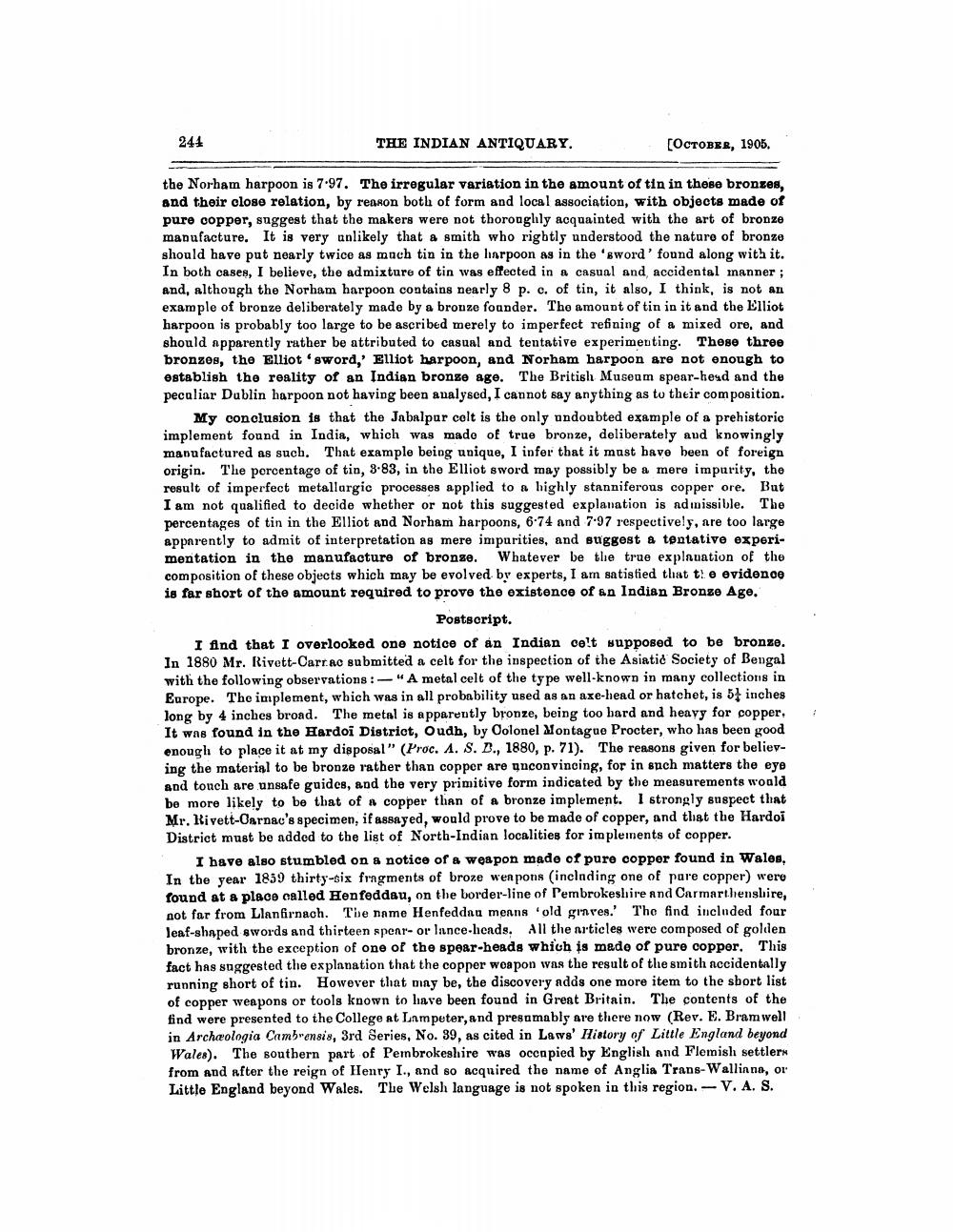________________
244
THE INDIAN ANTIQUARY.
[Остовив, 1905.
the Norham harpoon is 7.97. The irregular variation in the amount of tin in these bronzes, and their close relation, by reason both of form and local association, with objects made of pure copper, suggest that the makers were not thoroughly acquainted with the art of bronze manufacture. It is very unlikely that a smith who rightly understood the nature of bronze should have put nearly twice as much tin in the harpoon as in the 'sword' found along with it. In both cases, I believe, the admixture of tin was effected in a casual and, accidental manner; and, although the Norham harpoon contains nearly 8 p. c. of tin, it also, I think, is not an example of bronze deliberately made by a bronze founder. The amount of tin in it and the Elliot harpoon is probably too large to be ascribed merely to imperfect refining of a mixed ore, and should apparently rather be attributed to casual and tentative experimenting. These three bronzes, the Elliot 'sword,' Elliot harpoon, and Norham harpoon are not enough to establish the reality of an Indian bronze age. The British Museum spear-head and the peculiar Dublin harpoon not having been analysed, I cannot say anything as to their composition.
My conclusion is that the Jabalpur celt is the only undoubted example of a prehistoric implement found in India, which was made of true bronze, deliberately and knowingly manufactured as such. That example being unique, I infer that it must have been of foreign origin. The percentage of tin, 3-83, in the Elliot sword may possibly be a mere impurity, the result of imperfect metallurgic processes applied to a highly stanniferous copper ore. But I am not qualified to decide whether or not this suggested explanation is admissible. The percentages of tin in the Elliot and Norham harpoons, 6-74 and 7-97 respectively, are too large apparently to admit of interpretation as mere impurities, and suggest a tentative experimentation in the manufacture of bronze. Whatever be the true explanation of the composition of these objects which may be evolved by experts, I am satisfied that the evidence is far short of the amount required to prove the existence of an Indian Bronze Age.
Postscript.
I find that I overlooked one notice of an Indian celt supposed to be bronze. In 1880 Mr. Rivett-Carrac submitted a celt for the inspection of the Asiatic Society of Bengal with the following observations: "A metal celt of the type well-known in many collections in Europe. The implement, which was in all probability used as an axe-head or hatchet, is 5 inches long by 4 inches broad. The metal is apparently bronze, being too hard and heavy for copper, It was found in the Hardoi District, Oudh, by Colonel Montague Procter, who has been good enough to place it at my disposal" (Proc. A. S. B., 1880, p. 71). The reasons given for believing the material to be bronze rather than copper are unconvincing, for in such matters the eye and touch are unsafe guides, and the very primitive form indicated by the measurements would be more likely to be that of a copper than of a bronze implement. I strongly suspect that Mr. Rivett-Carnac's specimen, if assayed, would prove to be made of copper, and that the Hardoi District must be added to the list of North-Indian localities for implements of copper.
I have also stumbled on a notice of a weapon made of pure copper found in Wales, In the year 1859 thirty-six fragments of broze weapons (including one of pare copper) were found at a place called Henfeddau, on the border-line of Pembrokeshire and Carmarthenshire, not far from Llanfirnach. The name Henfeddau means 'old graves. The find included four leaf-shaped swords and thirteen spear- or lance-heads, All the articles were composed of golden bronze, with the exception of one of the spear-heads which is made of pure copper. This fact has suggested the explanation that the copper weapon was the result of the smith accidentally running short of tin. However that may be, the discovery adds one more item to the short list of copper weapons or tools known to have been found in Great Britain. The contents of the find were presented to the College at Lampeter, and presumably are there now (Rev. E. Bramwell in Archæologia Cambrensis, 3rd Series, No. 39, as cited in Laws' History of Little England beyond Wales). The southern part of Pembrokeshire was occupied by English and Flemish settlers from and after the reign of Henry I., and so acquired the name of Anglia Trans-Walliana, or Little England beyond Wales. The Welsh language is not spoken in this region. V. A. S.




